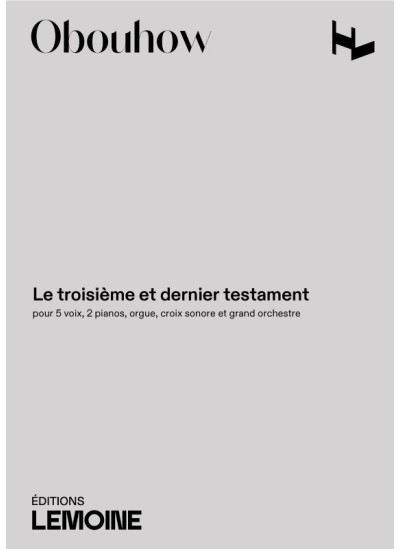
Le troisième et dernier Testament
5 voices, sonorous cross, 2 pianos, organ and orchestra
Nicolas Obouhow is born on April 22nd, 1892 and dead on June 13th, 1954.
He have studed piano and violin from an early age. In 1911 he began studies at the Moscow Conservatory, and he continued at the Saint Petersburg Conservatory from 1913 to 1916 where his teachers included Maximilian Steinberg and Nikolai Tcherepnin. A first concert of his compositions was given in 1915, and another in Saint Petersburg in 1916, in which all the music performed used a new method of music notation he had developed the preceding year.
In 1918 he fled Russia along with his family after the Bolshevik Revolution, settling in Paris where he met and studied with Maurice Ravel. He worked for the development of an electronic instrument, the croix sonore, a device similar to the theremin. Obouhow is most notorious for his gargantuan The Book of Life. Marie-Antoinette Aussenac-Broglie, one of his students, mastered the art of playing the croix sonore. She became one of the most vigorous proponents both of Obouhow's music and of his unusual electronic instrument, and she also provided him with a house and financial support.
Obouhow's compositional activity was partially interrupted by the Second World War, he published his treatise on harmony and notation in 1947, Traité d'harmonie tonale, atonale et totale. Honegger wrote the foreword to the book.
Rendered an invalid by an attack in 1949, he lived another five years, dying in Saint-Cloud, in the western suburbs of Paris. He is buried in the Cimetière de Saint-Cloud- atop his ruined monument was once a stone replica of his croix sonore, placed there by Marie-Antoinette Aussenac-Broglie.
Nicolas Obouhow is born on April 22nd, 1892 and dead on June 13th, 1954.
He have studed piano and violin from an early age. In 1911 he began studies at the Moscow Conservatory, and he continued at the Saint Petersburg Conservatory from 1913 to 1916 where his teachers included Maximilian Steinberg and Nikolai Tcherepnin. A first concert of his compositions was given in 1915, and another in Saint Petersburg in 1916, in which all the music performed used a new method of music...